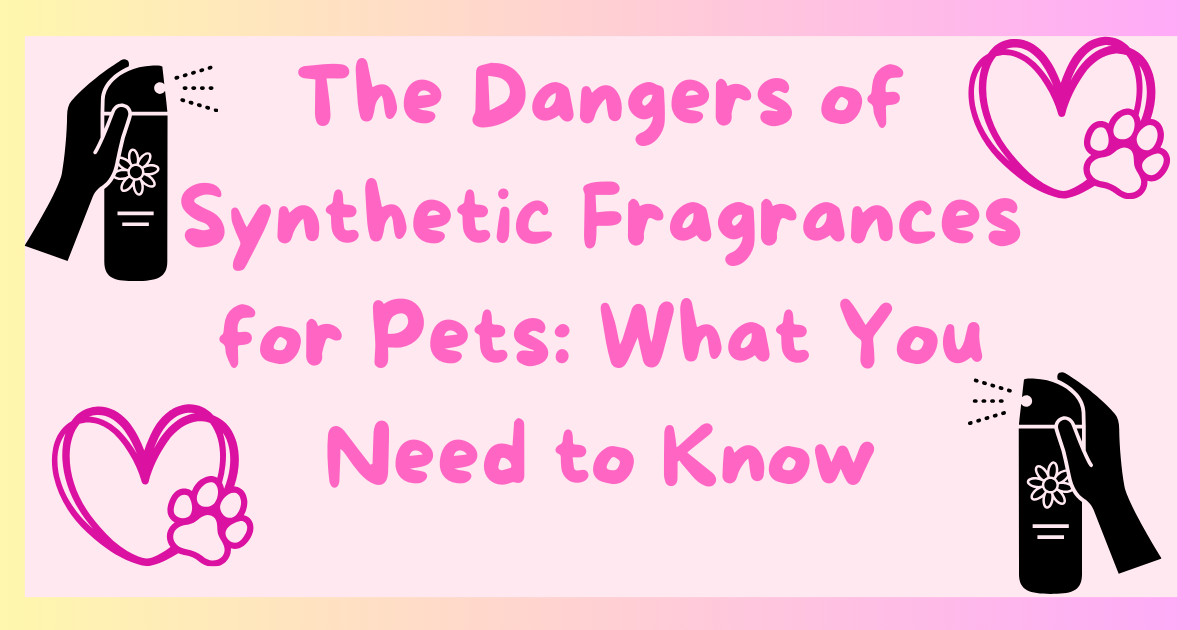
If you're like me and most pet owners, you want to keep your fur kids safe and healthy. We meticulously select their food, ensure they get enough exercise, and provide them with a loving home. But what about the air they breathe? Have you ever stopped to consider the impact of your indoor air quality on your pets' well-being?
The Impact on Indoor Air Quality
According to the Environmental Protection Agency (EPA), "indoor air pollution is often two to five times higher than outdoor air pollution levels, and in some cases, it can be up to 100 times higher." Two major sources of indoor air pollution include synthetic fragrances and cleaning products.
Synthetic fragrances are ubiquitous in our homes. They're found in air fresheners, cleaning products, candles, and even some pet grooming supplies. While they may make our homes smell pleasant, these fragrances can pose serious risks to us and our pets.
In addition to synthetic fragrances, cleaning products also contribute to indoor air pollution. Many household cleaners contain harsh chemicals such as ammonia, chlorine, and phthalates, which can release harmful fumes into the air. These chemicals can irritate the respiratory system, trigger allergies, and even pose long-term health risks with repeated exposure. Contrary to popular belief, you can clean your home without harsh chemical cleaning products. To easily start swapping out your cleaning products for safer alternatives, click HERE.
The Hidden Dangers
The ingredients used to create synthetic fragrances are often a closely guarded secret. Companies are not required to disclose the specific chemicals used, thanks to lax regulations in the fragrance industry. This lack of transparency means that consumers are largely in the dark about the potential dangers lurking in these products. This article published on ScienceDirect highlights that "fewer than 10% of air freshener ingredients are typically disclosed to the public".
Let's delve deeper into the hidden dangers of synthetic fragrances by highlighting three of the most harmful ingredients commonly found in these products:
- Phthalates: Phthalates are a group of chemicals used to enhance the scent of fragrances and prolong their staying power. These chemicals are known endocrine disruptors, meaning they can interfere with hormone production and regulation in both humans and animals. Phthalates have been linked to reproductive issues, developmental abnormalities, and an increased risk of certain cancers. Pets exposed to phthalates may experience hormone imbalances, reproductive problems, and other adverse health effects.
- Parabens: Parabens are widely used in a variety of consumer products such as air fresheners, perfumes, cosmetic products, and cleaning supplies, due to their effectiveness as preservatives and their low cost. Parabens are favored by manufacturers because they are inexpensive to produce and highly effective at inhibiting microbial growth, thereby prolonging the shelf life of products. Despite their widespread use, parabens have come under scrutiny in recent years due to mounting evidence suggesting potential health risks associated with their use. Studies have shown that parabens can mimic estrogen in the body, leading to hormone disruption and interference with the endocrine system. This has raised concerns about their possible role in the development of hormone-related cancers, such as breast cancer and prostate cancer.
- Volatile Organic Compounds (VOCs): VOCs are a diverse group of chemicals that easily evaporate into the air, contributing to indoor air pollution. Many synthetic fragrances contain VOCs such as benzene, toluene, and xylene, which can have harmful effects on health. These chemicals can irritate the respiratory system, trigger allergic reactions, and contribute to the development of asthma and other respiratory conditions. Long-term exposure to VOCs has been associated with neurological damage, liver and kidney dysfunction, and an increased risk of cancer. This article on ScienceDirect highlights that "Of all VOCs emitted, approximately one-fourth are classified as potentially toxic or hazardous under one or more federal laws in the US, and all air fresheners tested emitted one or more of these compounds."
While much of the research on these ingredients has been focused on their effects on humans, there is reason to be concerned about their impact on pets as well. Dogs and other pets, like humans, have endocrine systems that regulate hormone production and function. Given that pets often have closer contact with these products than humans do, either through direct application or environmental exposure, they may be at increased risk of adverse health effects.
Additionally, pets have unique physiological differences from humans, such as faster metabolic rates and different detoxification mechanisms, which may influence how they respond to chemical exposures and put them at greater risk. When exposed to these chemicals, pets can experience a wide range of adverse reactions, including respiratory issues, skin irritation, behavioral changes, and toxicity.
Creating a Safe Environment
Fortunately, there are steps you can take to minimize you and your pets' exposure to synthetic fragrances and create a safer environment for them:
Read Your Labels:
Given the prevalence of synthetic fragrances and harmful chemicals in household products, it's essential for you to become a savvy label reader. If I could only teach one thing, it would be to read your labels on each and every product you buy! Google 'dangers of' in front of any long words you can't pronounce and avoid any product that contains the word 'fragrance' like the plague!
Choose Natural Alternatives:
Look for products that are fragrance-free or use natural fragrances derived from essential oils. Avoid cleaners that contain fragrance, phthalates, formaldehyde, and other known toxins, opting instead for eco-friendly alternatives that are safer for both your pets and the environment. It's actually super easy to clean your home with natural based products that are also common household ingredients like vinegar and baking soda. For my top natural cleaning hacks, click HERE.
Opt for natural air fresheners, such as essential oil diffusers or homemade room sprays made with pet-safe essential oils. These alternatives can provide a pleasant aroma without the harmful chemicals found in synthetic fragrances. For an in depth article on replacing artificial air fresheners with essential oils, click HERE.
Keep in mind tho, that not all essential oils are created equally either. Quality is a number one safety factor in using essential oils safely in your home. The same trade secret loopholes and lack of disclosure mentioned previously, means that there is significant variation in the quality and purity of essential oils on the market, with some products containing synthetic additives, fillers, or contaminants that may pose risks to you and your pet's health.
Therefore, it's critical for you to research and choose reputable brands that prioritize transparency, quality control, and product purity. Look for companies that provide detailed information about their sourcing and production processes, own their farms, conduct third-party testing for purity and potency, and adhere to industry standards and best practices.
I invite you to check out the essential oil company that I've vetted, Young Living™ Essential Oils. Founded over 25 years ago, Young Living™ is a pioneer in the essential oil industry, known for its unwavering commitment to quality, purity, and sustainability. Unlike many other essential oil brands, Young Living™ controls every step of the production process, from Seed To Seal™.
They carefully select the finest botanicals from their own farms and trusted partner growers around the world, ensuring that each plant is grown in optimal conditions and harvested at the peak of its potency. Young Living™ is also committed to transparency, with an open door policy allowing you to visit the farms firsthand! I've had the pleasure of visiting several farms worldwide and helping to plant and harvest as well. Because of this, I have no doubt that I am only using a 100% pure and premium essential oil safe for me and my pets!
Join me in experiencing the benefits of Young Living™ Essential Oils and discover the difference that quality essential oils can make in you and your pet's life. Please note that the following link is an affiliate link, which means I earn a commission at no cost to you.
By ordering through my link, you'll not only receive access to Young Living's™ premium essential oils and oil-infused products, but you'll also be supporting my efforts to provide valuable information and resources to fellow pet owners like yourself. Join me by clicking HERE!
Your home is your oasis and you and your pets deserve a safe and healthy environment where you both can thrive. Synthetic fragrances may make our homes smell nice, but they can have serious consequences for us, our animals, and the environment. By educating yourself about the risks and taking proactive steps, you can create a healthy, thriving home. After all, our health and happiness are worth far more than any artificial scent.
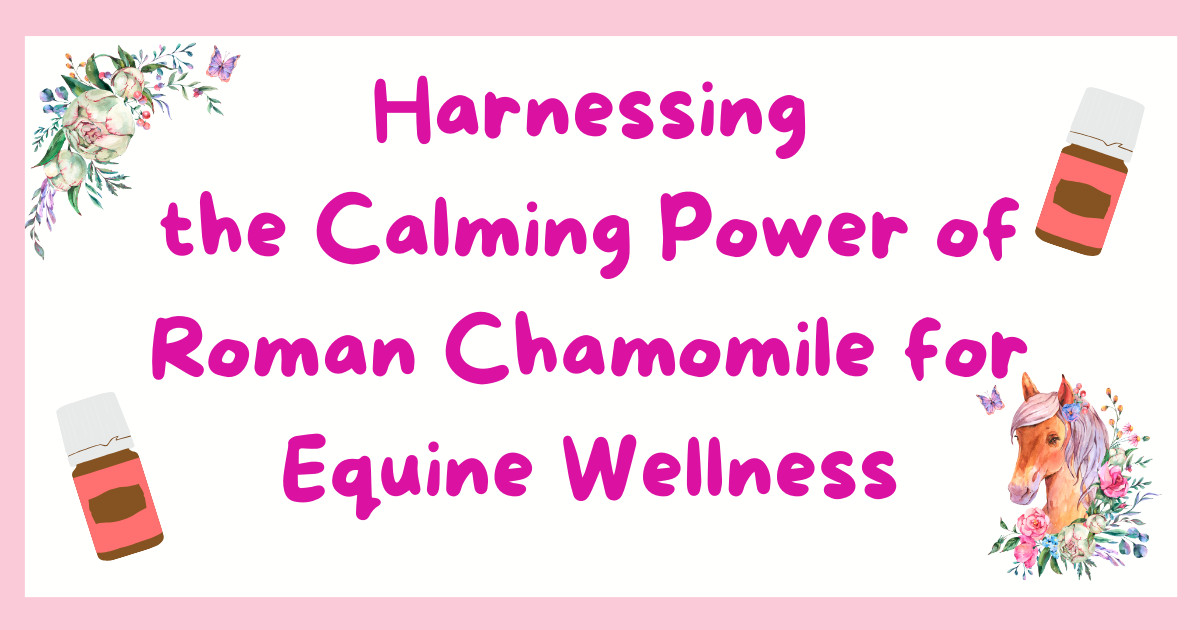
Relaxing Your Equine Companion: The Wonders of Roman Chamomile
One of my horses, Rolex, is currently on stall rest. He's handling it like a champ, but there's one thing that's caught my attention – his newfound fascination with Roman Chamomile essential oil. I've always loved the aroma of this essential oil and happened to have it in my pocket due to a particular stressful day (Roman Chamomile is renowned for its ability to alleviate feelings of tension). When I got to the barn, I decided to see how he liked it. He definitely perked up, smelled the bottle for a long time, then proceeded to try and eat the bottle-lol. There was definitely a noticeable change in his demeanor, as he can carry some worry even tho he's mostly calm. It's since become a part of our daily routine, a small but significant moment of connection in his stall that really seems to take the edge off. Lets dive in to Roman chamomile and what it can do for your horse!
Understanding Roman Chamomile:
Roman Chamomile, scientifically known as Chamaemelum nobile or Anthemis nobilis, is a perennial herb belonging to the Asteraceae family. It's native to Western Europe and North Africa, where it thrives in sunny, well-drained soils, boasting delicate, daisy-like flowers with white petals and yellow centers, and emitting a distinct apple-like aroma.
Treasured for centuries for its wellness properties, particularly its calming effects, Roman Chamomile's essential oil contains bioactive compounds like chamazulene, bisabolol, and apigenin, contributing to its soothing and wellness qualities.
Historically it was valued for its skin-soothing properties and its ability to promote relaxation and ease digestive discomfort. In modern times, Roman Chamomile remains prized for its versatility in aromatherapy, skincare, and digestive support, offering a natural remedy for overall well-being. Chamomile tea has become a staple in households as a bedtime relaxing beverage!
The Roman Connection:
The inclusion of "Roman" in the name "Roman Chamomile" carries with it a blend of historical significance and anecdotal charm. While there's a popular anecdote suggesting that the plant was named after a botanist who discovered it growing near the Roman Coliseum, the veracity of this claim remains uncertain. Instead, it's more likely that the association with Rome stems from the plant's historical usage by ancient Romans, who valued chamomile for its medicinal and aromatic properties.
The name "Roman Chamomile" may have been chosen to distinguish it from other chamomile species and to emphasize its esteemed status within Roman culture. Today, two popular types of chamomile essential oil used are Roman Chamomile and German Chamomile. While Roman Chamomile is celebrated for its gentle, apple-like aroma and calming properties, German Chamomile is known for its deep blue color. While I like to use use both with horses and dogs, Rolex's interest has Roman chamomile at the top of my list these days.
Using Roman Chamomile with Your Horse:
To utilize Roman Chamomile for relaxation with your horse:
- Offer the bottle for them to smell freely and as often as they'd like.
- Apply a drop to your palms, rub them together, and allow your horse to smell your hands, repeating as desired.
- Rub any residue on your horse's poll or the back of your neck for enhanced relaxation, recognizing that you are half the partnership with your horse and if you are calm and relaxed, you help them to be calm and relaxed.
Practical Applications:
Creating a spritzer can also be a great way to use the essential oil to promote calmness, such as before the farrier's visit or during trailering. Make a spritzer and spray the area your horse will be in before you bring the horse to the area. For example the grooming stall or horse trailer. If using chamomile for skin benefits, simply spritz the desired area. For a step by step guide to making a spray with some of my favorite recipes, click HERE.
Making a roller bottle is another easy and fun way to use your essential oils with your horse. You can then roll the oil or blend on your pulse points wearing it as a perfume, you then become a walking diffuser for your horse. By the way, this is one of the easiest ways to get started using essential oils with your horse, to learn more-go HERE.
For my guide to making roll on, click HERE. This method also works well for supporting your horse's digestive system by applying topically to their stomach or rubbing on your hands and massaging their abdomen.
Recipes for Relaxation:
Here are some of my favorite recipes for relaxation:
Roman Chamomile Massage Blend:
- 10 drops Roman Chamomile
- 5 drops Lavender
- 5 drops Frankincense
- 2 oz carrier oil (Like fractionated coconut oil, which is my fave. It's light, non greasy and absorbs quickly!)
Relaxation Spray:
- 15 drops Roman Chamomile
- 10 drops Cedarwood
- 5 drops Vetiver
- 2 oz spray bottle
- distilled water and vodka ( or witch hazel)
Add the essential oils to the spray bottle then fill up halfway with vodka and halfway with water. The vodka helps mix the essential oil with water. Swap the vodka out for alcohol free witch hazel if you are using it on wounds. Remember to shake well each time you spray.
Relaxer Roller:
- 10 drops Roman Chamomile
- 5 drops Cedarwood
- 5 drops frankincense
- 10 ml roller bottle
- carrier oil (Like fractionated coconut oil, which is my fave. It's light, non greasy and absorbs quickly!)
By the way frankincense is another powerhouse essential oil I use all the time with my horses. It's a fabulous addition to blends you are using to calm or balance emotions. To read more about using frankincense with your horses, click HERE.
Nurturing Your Bond
With Roman Chamomile by your side, every moment with your equine companion can become an opportunity for relaxation and deeper connection. Incorporating Roman Chamomile into a horse care routine can yield numerous benefits for equine health and well-being. From aromatherapy to topical application, its gentle yet potent properties offer a natural solution for promoting relaxation, comfort, and overall wellness in horses. So, whether it’s a soothing massage or a calming aroma, let the power of nature nurture your horse's well-being and enrich your bond together.
Quality Matters:
When it comes to essential oils, quality matters. Not all oils are created equal, and it's crucial to choose trusted suppliers who prioritize purity and authenticity. A recent study, published in the Journal of Essential Oil Research (JEOR), found that over 75% of lavender oils tested were adulterated, underscoring the importance of sourcing from reputable companies.
One such company I trust is Young Living™, renowned for their Seed to Seal® commitment. Their rigorous quality control measures ensure that every bottle of essential oil meets the highest standards of purity and potency. If you're looking for premium quality oil you can trust, safe for your four legged family, I invite you to explore Young Living's™ offerings. Click HERE to learn more and grab a bottle of Roman chamomile for your horse!
(Please note that the provided link is an affiliate link, and I may earn a small commission from your order at no additional cost to you. Your support is greatly appreciated as it helps support my small business!)
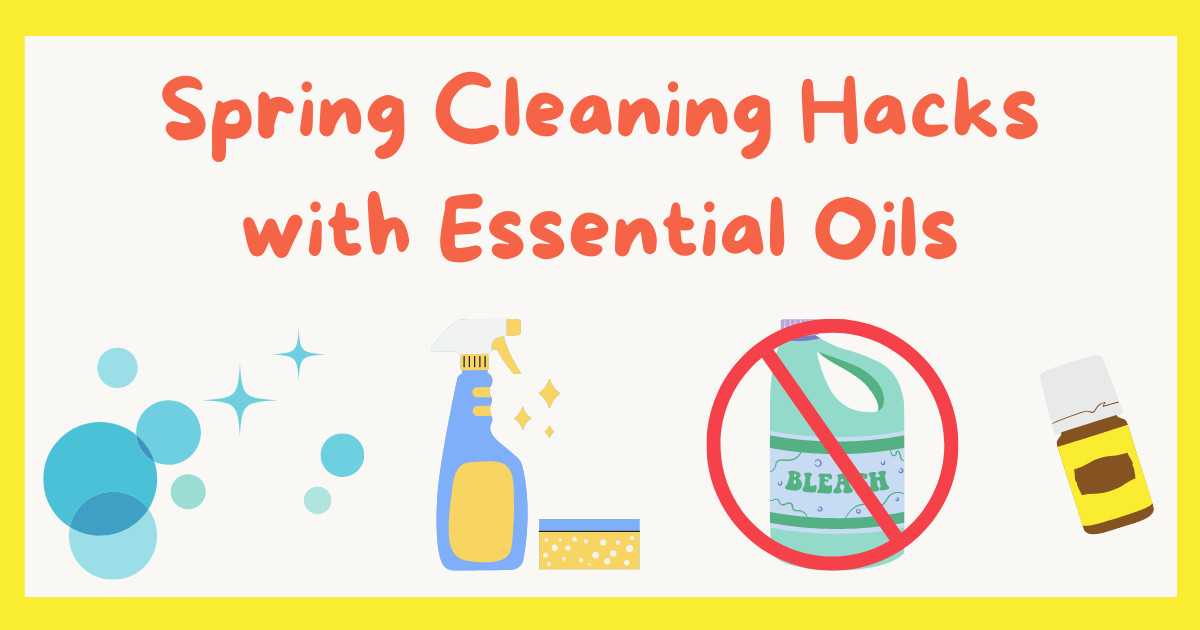
Spring is in the air, and with it comes the perfect opportunity to refresh our homes and create a clean, inviting space for both ourselves and our dogs. As pet owners, it's essential to consider the products we use during our spring cleaning routine, as many conventional cleaners can contain harmful chemicals that may negatively impact our pets' health. That's where products like vinegar and essential oils come in handy, offering a toxin free and pet-friendly alternative to traditional cleaning products. Plus you'll benefit from some aromatherapy too!
Also, let me share a little secret with you: you don't necessarily need to use essential oils in your cleaning routine, you can invest in a few products and get cleaning with out them, but why not? Essential oils not only add a delightful aroma to your cleaners, but many of them have also been studied for their germ-fighting capabilities. So, why not boost your cleaning with some extra power and a pleasant scent? Whether you're using lemon for its fresh fragrance and natural wellness properties or tea tree oil as its been studied for antifungal and antiviral qualities, essential oils can elevate your cleaning experience. So go ahead, add a few drops of your favorite essential oil to your homemade cleaners and enjoy the benefits of a fresh, clean home with a touch of aromatherapy.
My top natural cleaning substitutes include baking soda, vinegar, hydrogen peroxide, Castile soap, and of course, essential oils-lol!
-Baking soda, with its gentle abrasive properties, is commonly used for scrubbing surfaces and absorbing odors.
-Vinegar is prized for its acidic nature, which makes it effective at cutting through grease and disinfecting surfaces.
-Hydrogen peroxide is known for its antibacterial and antifungal properties, making it a powerful disinfectant.
-Castile soap, made from vegetable oils, is a versatile cleaner that is gentle yet effective on a variety of surfaces, as well as your hands.
-Essential oils add a fabulous aroma and many have been studied for properties that go hand in hand with cleaning. This review on Pubmed.org titled 'Essential Oils as Antimicrobial Agents-Myth or Real Alternative?' states that "According to available papers and patents, EOs seem to be a potential alternative to synthetic compounds".
These natural alternatives are popular choices for eco-conscious individuals seeking safer and more sustainable cleaning solutions.
Hands down, the number one thing to do when it comes to cleaning is to start with the basics: soap and water. It's simple, effective, and readily available. Many times, we underestimate the power of this duo. Interestingly, many labels on harsh chemical cleaners advise you to clean the surface first with soap and water, which effectively removes organic matter. This step alone can significantly improve the efficacy of any cleaner that follows.
Ah, let's talk about Castile soap, my absolute favorite when it comes to soap. Originating from the Castile region of Spain, this gentle soap has been prized for centuries for its purity and versatility. What sets Castile soap apart is its simple yet effective formula, typically made from 100% plant-based oils like olive oil or hemp oil.
Unlike many commercial soaps that contain harsh detergents, synthetic additives, and artificial fragrance, Castile soap is incredibly gentle on the skin, making it suitable for even the most sensitive individuals. Its moisturizing properties leave your hands feeling soft and nourished, without any drying or irritation. Plus, it's biodegradable and environmentally friendly, making it a sustainable choice for both your home and the planet.
Whether used for handwashing, body cleansing, or household cleaning, Castile soap is a true multitasker that's as gentle as it is effective. Once you try it, you'll wonder how you ever lived without it!
However, if you do feel the need for something extra, my next choice is vinegar. Vinegar is a versatile, natural cleaner that can tackle a variety of surfaces and stains with ease, making it a staple in my cleaning arsenal. To make your own vinegar cleaner, simply mix equal parts distilled white vinegar and water in a spray bottle. Super easy-right?!
Of course, I would then also add one of my favorite essential oils, such as tea tree oil or lemon oil, for added cleaning properties and a pleasant scent. Shake the bottle well to mix the ingredients, and voila! You have a homemade cleaner that's safe, effective, and eco-friendly. Use it to clean surfaces throughout your home, from kitchen countertops to bathroom sinks. With this simple recipe, you can clean your home with confidence, knowing that you're using a natural cleaner that's tough on germs but gentle on the environment and safe for you and your pets!
However, there are a few surfaces where vinegar should be avoided. It's not recommended for use on natural stone countertops like granite or marble, as the acidity can dull or etch the surface. Plain ol' soap and water is fine for those surfaces.
Avoid using vinegar on unsealed grout, as its acidic nature can weaken and deteriorate the grout over time. Instead, opt for a gentle yet effective solution like a baking soda paste. Simply mix baking soda and water until a paste forms, then apply it to the grout lines for safe and efficient cleaning.
Additionally, vinegar should not be used on electronic screens such as TVs or smartphones, as it can damage protective coatings. Simply use a damp microfiber cloth instead.
Say goodbye to harsh chemical bleach and hello to a safer, more eco-friendly alternative. Enter hydrogen peroxide, a powerful yet gentle bleach alternative that's perfect for brightening whites, disinfecting surfaces, and tackling tough stains. Unlike traditional bleach, hydrogen peroxide breaks down into water and oxygen, leaving behind no harmful residues. It's particularly effective for removing stains from clothing, whitening grout, and disinfecting kitchen and bathroom surfaces. Plus, it's safe to use around pets and won't harm the environment.
If I had to choose just one product to eliminate from my cleaning routine, it would undoubtedly be bleach. I always wondered why I got a headache when I would use bleach. Then I noticed my dogs would avoid the area like the plague. Then I started reading my labels, and, well- its scary stuff on the back of your bleach bottle! Not only is bleach harmful to our health and the environment, but its harsh chemicals can also cause respiratory issues and skin irritation. Moreover, bleach releases toxic fumes, posing a serious risk to indoor air quality. It's easy to opt for a safer and more eco-friendly alternative like hydrogen peroxide.
I love creating my own bleach alternative recipe using hydrogen peroxide and the uplifting scent of lemon essential oil. It's simple yet effective, providing a safe and natural way to disinfect surfaces. To make this recipe, I mix equal parts hydrogen peroxide and water in a spray bottle. Then, for an extra boost of power and a delightful fragrance, I add 20 drops of lemon essential oil for every 2 cups of the solution.
Before we dive into my favorite essential oils for cleaning, let's have a chat about the quality of essential oils. It's true, not all essential oils are created equal. A recent study published in the Journal of Essential Oil Research (JEOR) sheds light on this issue. The study analyzed 41 authentic lavender essential oil samples from trusted producers and research partners worldwide. Comparing these findings to 12 commercially available samples, the study made a startling discovery: 9 out of 12 (75 percent) of the commercially available samples were adulterated.
This means they showed signs of potential dilution or the addition of another oil as a substitute. Now, our goal here is to clean our homes with safe and natural products, right? We're aiming to rid our living spaces of harmful chemicals, not add more to the mix. That's why choosing a high-quality and pure essential oil is absolutely paramount.
Sure, it might cost a bit more upfront, but here's the kicker: these oils are super concentrated plant extracts, so a little goes a long way. Investing in quality ensures that you're getting the real deal and maximizing the benefits of these powerful natural extracts. It's all about quality over quantity when it comes to using essential oils.
My Favorite Essential Oils for Spring Cleaning
1. Lemon Essential Oil: Lemon oil is well known as a powerful ingredient for cleaning. Lemon essential oil has even been studied for cleaning! Plus, its fresh citrus scent helps to uplift the mood and leave your home smelling clean and fresh.
2. Tea Tree Essential Oil: Tea tree oil, also known as melaleuca oil, has been studied as a potent antiseptic and antifungal agent, making it an excellent choice for cleaning surfaces in bathrooms and kitchens. Tea tree oil has been mentioned in many articles about helping to combat mold, mildew, and bacteria, making it a versatile choice for household cleaning.
3. Lavender Essential Oil: Lavender oil not only has a calming and relaxing aroma, perfect for a multiple dog household, but it also has been studied for its antifungal properties. It's great for freshening up laundry, deodorizing carpets, and adding a pleasant and relaxing scent to homemade cleaning products.
4. Pine Essential Oil: Pine oil has a fresh, forest-like aroma and is synonymous with the aroma of cleaning (think Pine-Sol™). It has also been studied for its antimicrobial and anti fungal properties, making it an excellent choice for adding to DIY cleaning products and freshening up the air in your home.
5. Eucalyptus Essential Oil: Eucalyptus oil is known for its fresh, clean aroma and its ability to help support breathing and purify the air, making it another ideal choice for DIY cleaning products and freshening up your home.
Let's take charge of our health and environment by gradually replacing conventional products with safer, natural alternatives. Making small adjustments to our daily cleaning routine allows us to reduce exposure to harmful toxins and prioritize overall well-being. It's a simple yet impactful way to safeguard our health and the planet. Safety is key, especially in homes with pets. Many commercial cleaning products contain harsh chemicals that pose risks to both humans and animals. In contrast, safer products like vinegar, hydrogen peroxide, and essential oils can provide a gentle yet potent solution for cleaning without endangering us or our fur kids!
By the way, remember the importance of quality when it comes to essential oils? I invite you to check out my go-to source for essential oils, Young Living™. With their Seed to Seal™ guarantee, there's no chance of adulteration here. I've also curated a bundle of these essential oils, making it easy for you to revamp your cleaning routine with natural ingredients. And if you're not one for DIY projects, be sure to check out Thieves™ Cleaner . It's incredibly concentrated, yielding up to twenty nine 16 oz. cleaning bottles from just one concentrate, actually making it cheaper than what you'll find in the store—wow! Click HERE to learn more and start your journey to a healthier home.
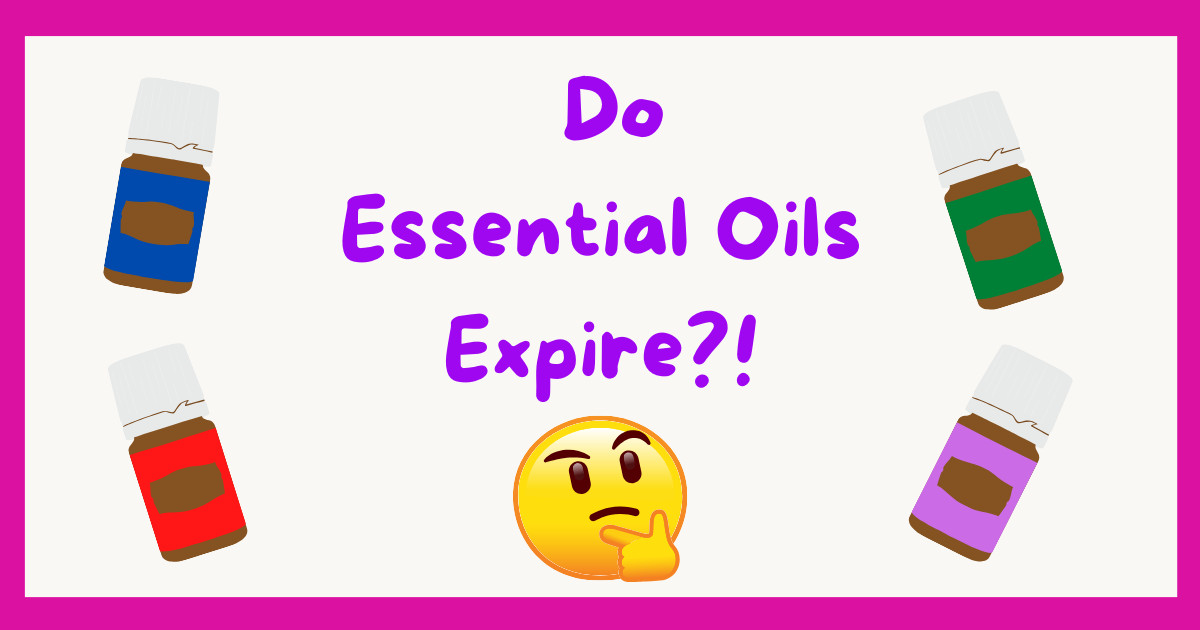
As a seasoned enthusiast of essential oils, one question that I often see is, "Do essential oils expire?" The answer may not be as straightforward as you think. While essential oils technically don't have an expiration date like perishable foods, they do undergo a process called oxidation, which affects their potency and quality over time. In this blog, let's discover how long your favorite oils last, how to store them properly, and what to do if they've gone bad.
Understanding Oxidation:
Oxidation isn't just a surface-level thing; it's a chemical reaction that occurs when essential oils meet oxygen. Picture it like leaving a slice of apple out on the counter—it starts to turn brown because of oxidation. The same thing happens with oils! When they're exposed to air, light, and warmth, they slowly lose their freshness and potency. This means their aroma might change, their color might fade, and their wellness benefits might not be as powerful as they once were. When it comes to how long your essential oils stay fresh, quality and storage are key players.
Tips to Maximize Shelf Life:
1. Purchase high-quality essential oils:
- Investing in high-quality oils ensures that you're starting with a product that has been properly sourced and processed. High-quality oils are less likely to contain impurities or additives that could accelerate degradation, and even be harmful. Quality also plays a crucial role in using essential oils safely, especially when incorporating them into your pet care routine.
2. Keep in dark-colored glass bottles:
- Dark-colored glass bottles, like amber or cobalt blue, offer effective protection against light exposure, a factor known to degrade essential oils over time. These opaque containers serve to shield oils from light, thereby preserving their potency and aroma for extended periods. It's worth noting that high-quality essential oils are typically packaged in such bottles. If you encounter oils sold in clear containers, exercise caution as they may contain fragrance oils rather than pure essential oils.
3. Store in a cool, dark place:
- Heat and light are two of the main factors that can accelerate the degradation of essential oils. Storing oils in a cool, dark place, such as a pantry or cabinet away from direct sunlight and heat sources, helps maintain a stable temperature and minimizes the risk of oxidation.
4. Store upright:
- Storing essential oil bottles upright with the lid securely fastened is important for preventing leakage and minimizing exposure to air, a significant factor contributing to oxidation and the decline in oil quality. Essential oils have a degrading effect on plastic over time, particularly when there is constant contact. By storing bottles upright, you reduce the frequency of contact between the oil and the plastic orifice reducer and lid, thereby slowing down the breakdown process and prolonging the lifespan of both the oil and the bottle components.
5. Consider refrigeration for long-term storage:
- Refrigeration can be beneficial for extending the shelf life of certain essential oils, especially those prone to oxidation or with shorter shelf lives. Cold temperatures slow down the chemical reactions that lead to degradation, preserving the freshness and efficacy of the oils over time. Personally, I keep all of my citrus essential oils in the fridge.
6. Track purchase dates with an inventory sheet:
- Tracking your essential oil purchase dates not only helps you keep tabs on their age but also prevents you from accidentally buying duplicates until you've used up what you have. This way, you can ensure you're using oils while they're still fresh and in their prime. For an easy, non-branded inventory sheet, click HERE.
By following these tips, you can maximize the shelf life of your essential oils, ensuring that they remain potent and effective for all your aromatherapy and wellness needs.
Most essential oils, when stored properly, typically maintain their quality for 1 to 5 years. Citrus essential oils are the most prone to oxidation and generally last around a year. Some oils, like Patchouli, Sandalwood, and Oregano can often remain effective for 6 to 8 years.Here are some general guidelines for understanding essential oil shelf life:
- Citrus Oils: These essential oils, like lemon, lime, and orange, have a shorter shelf life, typically around 1-2 years. Citrus essential oils contain high levels of limonene, a compound prone to oxidation when exposed to air, light, and heat. Additionally, their high volatility causes rapid evaporation, leading to increased oxygen exposure and faster oxidation.
- 2–3 years: Black Pepper, Copaiba, Cypress, Frankincense, Helichrysum, Lemongrass, Melissa, Rosemary, Spearmint, and Tea Tree
- 3–4 years: Cardamon, Cinnamon Bark, Clary Sage, Eucalyptus Globulus, Lavender, Myrrh, Thyme, and Vanilla oleoresin
- 4–5 years: Blue Tansy, Cedarwood, Peppermint, Wintergreen, and Ylang Ylang
- Over 5 years: Oregano, Sandalwood, Patchouli, Vetiver
How do you know if your essential oil is oxidized?
Here's what to look for:
- Change in Aroma: Oxidized oils often develop a different smell, distinct from their original aroma. When in doubt, smell it! If it still smells good, odds are its ok.
- Altered Color: Look for changes in color, such as darkening or cloudiness, which may indicate oxidation.
- Loss of Potency: Oxidized oils may lose their wellness properties and efficacy, resulting in reduced effectiveness in aromatherapy or topical applications. If you think you're not getting the results you should when using a particular oil, oxidation may be a factor.
- Evaporation: Citrus oils, in particular, are prone to evaporation even when tightly sealed, as the volatile compounds responsible for their aroma can escape through the bottle's cap over time. This can lead to a noticeable decrease in the oil's volume without it being opened. I've also noticed this with pine essential oil!
- Consistency: Pay attention to the consistency of the oil. An oxidized oil may be thinner or thicker than you remember, indicating changes in its chemical composition and potential degradation.
- Comparison: Compare the aroma and appearance of the oil with a fresh bottle if you have one, to detect any noticeable differences indicative of oxidation.
Assessing your essential oils for these variations allows you to effectively gauge their quality and condition, helping you decide if they're still suitable for your daily wellness routine.
Why Avoid Using Oxidized Oils:
Avoiding the use of oxidized oils is important for maintaining the effectiveness and safety of your essential oil collection. When oils oxidize, they can lose their wellness properties and develop an unpleasant smell, making them less enjoyable to use. Moreover, oxidized oils may increase the risk of skin irritation or adverse reactions, undermining their intended benefits.
Alternative Uses for Oxidized Oils:
Despite the diminished aroma and wellness properties of oxidized oils, there are still practical ways to repurpose them effectively. One creative solution is to incorporate these oils into homemade cleaning products. Essential oils, even when oxidized, can be harnessed for natural cleaning. By adding oxidized oils to DIY cleaning sprays, surface cleaners, or laundry detergents, you can still harness their residual benefits. To learn more about cleaning your home with natural products, check out my dedicated blog post HERE.
Additionally, if the oil still smells good, it can be used in crafting projects such as making candles or scented sachets, where the primary focus is on aroma rather than wellness efficacy. By repurposing oxidized oils in these innovative ways, you can minimize waste and maximize the utility of your essential oil collection, turning what might have been considered unusable into valuable assets for household chores and creative endeavors.
While essential oils don't technically expire, they do have a shelf life influenced by oxidation. By understanding the factors that contribute to oxidation and implementing proper storage techniques, you can prolong the potency and quality of your oils, helping ensure that you benefit from their wellness properties and desired outcomes.
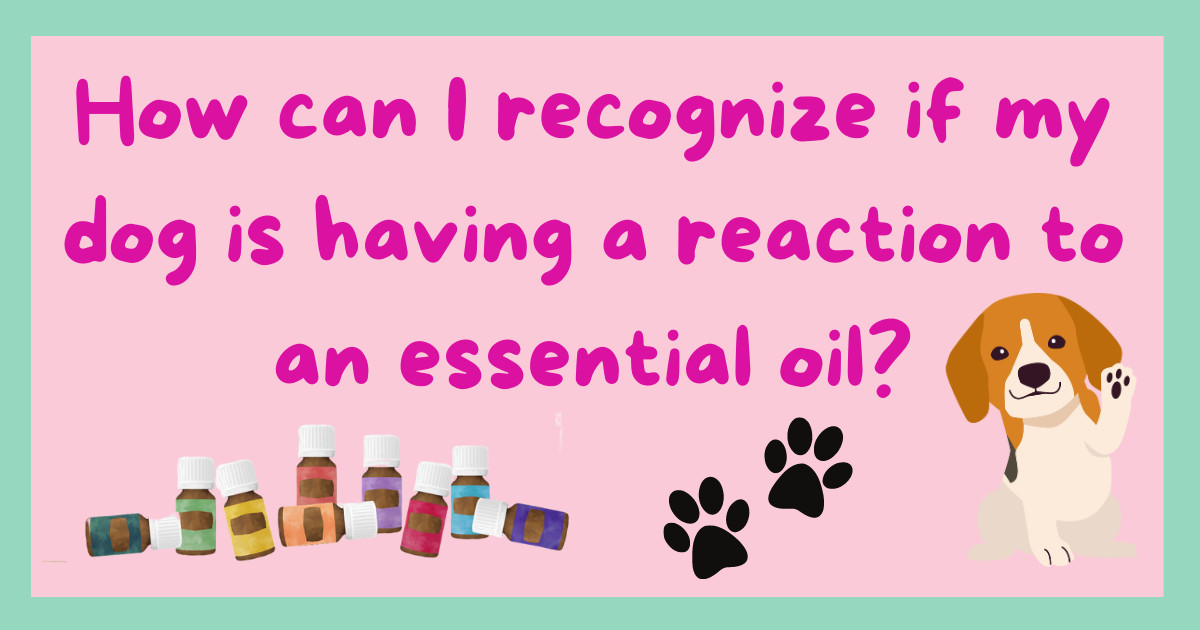
Hey there, fellow dog moms and wellness enthusiasts! So, today I've had a very good question come in from a gal who's just started diffusing essential oils and noticed her dog started to cough. She was wondering if it could be related, and that's a great question! So, this week's blog is dedicated to what to look for when using essential oils with your dog to make sure it's all going okay.
This discussion is not meant to deter essential oil use in dogs; in fact, I've been incorporating essential oils into my own dogs' wellness routines for over 8 years now. Take BB, for example, my infamous 5-pound Chihuahua – he's been benefiting from essential oils alongside me every step of the way. Essential oils are undeniably a valuable tool in the wellness toolbox for our furry companions.
When using premium and pure unadulterated essential oils properly, the likelihood of adverse reactions in dogs is significantly reduced. In fact, when sourced from reputable suppliers and applied with care, these high-quality oils can offer a myriad of benefits to our furry companions. Essential oils have been celebrated for their natural wellness properties for centuries, and when used responsibly, they can be a valuable tool in supporting our dogs' overall well-being. From soothing skin and supporting healthy fur, to promoting relaxation and emotional balance, the wellness potential of essential oils is vast.
However, it's crucial to recognize that every dog is unique, and not all essential oils are created equal. That's why my motto when using essential oils with your dog is simple: go low, go slow, and observe. This blog is dedicated to helping you do just that – observing and understanding how essential oils can best serve your dog's health and happiness.
First off, let's talk about why essential oils might cause a reaction in dogs.
Essential oils are potent plant extracts derived from various aromatic plants and herbs. While these oils offer a plethora of wellness benefits for humans and animals alike, it's essential to recognize that dogs, like humans, can have individual sensitivities and physiological differences that may influence their response to these concentrated compounds.
One primary reason why essential oils might cause a reaction in dogs is their unique physiology. Dogs have a highly sensitive sense of smell and a different metabolic rate compared to humans. Their bodies metabolize substances at varying rates, and what may be safe for us could potentially overwhelm their systems.
Additionally, certain chemical components present in essential oils could have the potential to trigger reactions in sensitive individuals. Common constituents found in many essential oils may cause different responses in some dogs.
Moreover, the method of application plays a significant role in how dogs interact with essential oils. Inhalation, topical application, and ingestion are the primary routes of exposure. All three methods can be safe and benefit your dog. To read more about the three methods of application, click HERE.
If you are just starting out, inhalation is the easiest and safest method. Diffusing essential oils with a diffuser is a fabulous way for you and your dog to enjoy the benefits of essential oils. Using a water based ultrasonic diffuser dilutes the essential oil. Click HERE for my in depth blog about diffusing essential oils with your dog.
Topical application is another great way to use essential oils with dogs. Diluting the essential oil with a carrier oil like fractionated coconut oil minimizes any chance of a skin reaction. Click HERE to read more about carrier oils for topical use. If applied undiluted or in high concentrations, you could see skin irritation or sensitization. If this occurs, simply add more carrier oil, this will further dilute the essential oils and slow the absorption rate to a level your dog can tolerate.
Ingesting essential oils can provide additional benefits, but it's important to exercise mindfulness when considering this practice. Ensure the quality and suitability of the essential oil, understand your reasons for internal use, and consider your dog's health and condition. Only use essential oils labeled for ingestion, and always read your labels carefully. Working with a holistic veterinarian trained in essential oil use can provide valuable guidance and support for this method.
Interestingly, many dog foods on the market today contain essential oils as natural preservatives, meaning your dog may already be ingesting them to some extent. While ingestion remains a somewhat controversial topic in the essential oils world, it's essential to understand that you can experience the benefits of essential oils through various methods. If you're uncomfortable with ingesting oils, simply opt for alternative methods. Remember, the skin is our largest organ, and what we apply topically gets absorbed into the body. Likewise, inhaling essential oils allows absorption through the lungs. While ingestion can be a valuable tool, it's not a requirement for reaping the benefits of essential oils.
It's also essential to consider the quality and purity of the essential oils being used. Low-quality oils may contain contaminants or adulterants that can exacerbate adverse reactions in dogs. Opting for high-quality, premium-grade oils from reputable sources can minimize the risk of adverse effects.
Now, you might be wondering, how can I tell if my dog is having a reaction to an essential oil? Here are some signs to watch out for:
- Skin Irritation: Keep an eye out for redness, itching, or irritation on your dog's skin after applying or diffusing essential oils. This could manifest as rashes, hives, or hot spots. Pay close attention to areas where the oil was applied.
- Excessive Scratching or Licking: If your dog starts scratching or licking themselves more than usual, it could indicate a reaction. Persistent scratching, especially around the ears, face, or paws, may signal discomfort or irritation.
- Respiratory Issues: Watch for abnormal breathing signs, such as coughing, wheezing, sneezing, or even heavy breathing. Dogs with sensitive respiratory systems may be overwhelmed with airborne essential oil particles, particularly in poorly ventilated spaces.
- Digestive Upset: Keep an eye on your pup's digestive health. Symptoms like vomiting, diarrhea, or excessive drooling could indicate that their stomach isn't tolerating certain essential oils well.
- Behavioral Changes: Pay attention to any unusual behavior exhibited by your dog after exposure to essential oils. This could include lethargy, restlessness, agitation, stupor, or changes in appetite. Dogs may show signs of discomfort or distress through their behavior.
- Swelling or Inflammation: Be vigilant for any swelling or inflammation, particularly around the face, muzzle, or eyes. These are common areas where reactions may manifest.
Alright, now that we've covered the signs of an adverse reaction, let's talk about what to do if you suspect your dog is experiencing one:
- Stop Use Immediately: If you suspect your dog is reacting to essential oils, stop using the essential oil. If you were diffusing the oil, ensure proper ventilation and remove your dog from the area.
- Dilute Further: If the oil was applied topically, further dilute it with additional carrier oil to lessen its potency and slow down absorption, making it better tolerated by the body. Since essential oils do not mix with water, attempting to rinse the oil off can actually drive it further into the skin. Instead, remember that essential oils are lipid-loving (attracted to fat), so adding more carrier oil will effectively bind with the essential oil.
- Evaluate: Delve into the specific essential oil you used and its application method. Often, reactions stem from issues related to quality or excessive usage. If symptoms persist despite discontinuing oil use and additional dilution, consult a veterinarian promptly. Your vet can offer expert guidance, recommend appropriate treatments, and provide supportive care to alleviate your dog's symptoms effectively.
- Monitor Your Dog: Keep a close eye on your dog and monitor their condition closely. Note any changes in their symptoms and behavior, and be prepared to provide updates to your vet if necessary.
- Prevention is Key: Moving forward, take a look at the essential oil you were using, the quality, and how you were using it. You might have just used too much, you might have used an inferior oil with contaminants, or your dog may truly be sensitive to that essential oil. There are over 300 plants that are distilled for essential oils on the market and many have similar benefits, so moving forward consider consulting with a holistic veterinarian trained in the use of essential oils or canine aromatherapist for guidance to use the right essential oil for your dog.
When encountering issues with essential oils, it's crucial to recognize that the root cause is often linked to the quality of the oil and how it was used. High-quality, pure essential oils sourced from reputable suppliers undergo rigorous testing and adhere to strict quality standards, ensuring that they are free from contaminants, adulterants, and harmful chemicals. However, lower-quality oils and those that have been improperly used pose a greater risk of adverse reactions in dogs.
Additionally, the method of application plays a significant role in determining the outcome. Diluting oils appropriately, using them in well-ventilated spaces, and respecting each dog's individual sensitivities are essential practices to minimize the likelihood of problems. By prioritizing the use of premium oils and employing proper techniques, we can provide our furry friends with the safest and most beneficial experience when incorporating essential oils into their wellness regimen.
Ready to take your knowledge of essential oils and your dog's well-being to the next level? Join me in my Oily Dog Intro course, where we'll take a deep dive into safely using essential oils with your furry companion. Whether you're new to essential oils or looking to expand your expertise, this course is designed to empower you with the knowledge and confidence to support your dog's health naturally. Don't miss out – sign up today and embark on a journey to holistic wellness for you and your canine companion! Click HERE!







